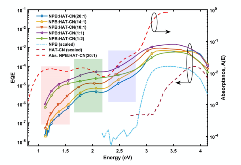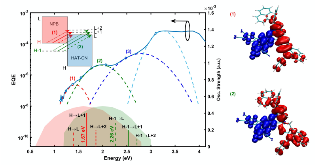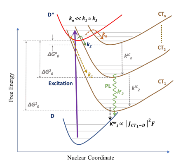Multiple Charge Transfer States in Donor–Acceptor Heterojunctions with Large Frontier Orbital Energy Offsets
- Princeton Univ., NJ (United States); Princeton University
- Univ. of Mons (Belgium)
- Princeton Univ., NJ (United States)
- Univ. of Grenoble (France)
- Univ. of Bologna (Italy); Univ. of Bordeaux (France)
- Pennsylvania State Univ., University Park, PA (United States)
- Ecole Polytechnique Federale Lausanne (Switzlerland)
Here, we demonstrate several organic amorphous donor–acceptor systems that exhibit sub-bandgap features over a more than 2 eV spectral range. An in-depth study of one of these systems, NPB:HAT-CN (NPB is N,N'-di(1-naphthyl)-N,N'-diphenyl-(1,1'-biphenyl)-4,4'-diamine and HAT-CN is 1,4,5,8,9,11-hexaazatriphenylenehexacarbonitrile), reveals that the broad sub-bandgap features are attributed to multiple electronic charge transfer (CT) state transitions, broadened by energetic disorder sourcing from the fluctuations of intramolecular conformations and by the disordered intermolecular environment. These unique CT features originate from an unconventional donor and acceptor selection that reveals new insight about photocurrent generation and nonradiative recombination. Unlike materials employed in high performing organic solar cells, the materials studied here feature large optical energy gaps with very large frontier orbital energy level offsets, creating high bandgap devices with low open-circuit voltage. In addition to multiple electronic CT levels, we reveal that the internal quantum efficiency of these multiple CT transitions is not constant but photon energy dependent and with photoluminescence that originates primarily from the second lowest electronic CT state implying slow (relative to radiative and nonradiative rates) internal conversion within the CT manifold. In general, this class of donor–acceptor pairs provides an opportunity to probe CT states in unique ways to potentially unravel their role in carrier generation–recombination and energy loss mechanisms.
- Research Organization:
- Princeton Univ., NJ (United States); Pennsylvania State Univ., University Park, PA (United States)
- Sponsoring Organization:
- USDOE Office of Science (SC), Basic Energy Sciences (BES) (SC-22)
- Grant/Contract Number:
- SC0012458; SC0012365
- OSTI ID:
- 1595398
- Journal Information:
- Chemistry of Materials, Journal Name: Chemistry of Materials Journal Issue: 17 Vol. 31; ISSN 0897-4756
- Publisher:
- American Chemical Society (ACS)Copyright Statement
- Country of Publication:
- United States
- Language:
- English
Similar Records
Quantifying and Understanding Voltage Losses Due to Nonradiative Recombination in Bulk Heterojunction Organic Solar Cells with Low Energetic Offsets
Interaction between organic semiconductors and LiF dopant




